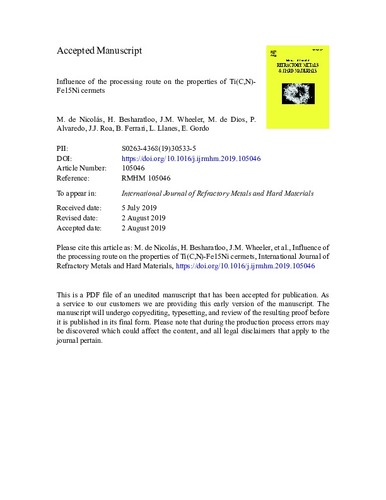Mostra el registre d'ítem simple
Influence of the processing route on the properties of Ti(C,N)-Fe15Ni cermets
| dc.contributor.author | Nicolás Morillas, Maria de |
| dc.contributor.author | Besharatloo, Hossein |
| dc.contributor.author | Wheeler, J.M. |
| dc.contributor.author | Dios Pérez, Miguel de |
| dc.contributor.author | Alvaredo Olmos, Paula |
| dc.contributor.author | Roa Rovira, Joan Josep |
| dc.contributor.author | Ferrari, B |
| dc.contributor.author | Llanes Pitarch, Luis Miguel |
| dc.contributor.author | Gordo Odériz, Elena |
| dc.contributor.other | Universitat Politècnica de Catalunya. Doctorat en Ciència i Enginyeria dels Materials |
| dc.contributor.other | Universitat Politècnica de Catalunya. Departament de Ciència i Enginyeria de Materials |
| dc.date.accessioned | 2020-10-26T10:59:17Z |
| dc.date.available | 2022-02-01T01:28:14Z |
| dc.date.issued | 2020-02-01 |
| dc.identifier.citation | Nicolás, M. [et al.]. Influence of the processing route on the properties of Ti(C,N)-Fe15Ni cermets. "International journal of refractory metals and hard materials", 1 Febrer 2020, vol. 87, p. 105046/1-105046/9. |
| dc.identifier.issn | 0263-4368 |
| dc.identifier.uri | http://hdl.handle.net/2117/330783 |
| dc.description.abstract | This study aims to understand the influence of powder preparation and processing steps on the microstructure and properties of Ti(C,N)-Fe15Ni cermets with 70 and 80 vol% of ceramic phase. Two routes were used for powder preparation: (i) a colloidal approach, consisting of the preparation of stable aqueous suspensions of the powder particles and spray-drying to obtain easy-to-press granules, and (ii) conventional powder metallurgy route, consisting on wet ball milling of powders, with subsequent drying in rotary evaporator. The resultant powder mixtures were uniaxially pressed and sintered in high-vacuum at 1450¿°C for 2¿h. Sintered samples were characterized in terms of their density, porosity, microstructure (FESEM, image analysis), composition (EDX and XRD), small-scale hardness and sliding contact response by means of massive nanoindentation and nanoscratch testing. C content of the mixture powders was lower for conventional route, lost during milling. After sintering, all the materials, despite the processing route and composition, show C reduction, although that outflow is higher for the conventional powder metallurgy route, and more evident for the composition with higher binder content. As a result, COL samples exhibit a more homogeneous microstructural assemblage, higher small-scale hardness and mechanical integrity under sliding contact conditions. Compositions of materials must then be adjusted to adequate initial C addition with respect to the employed processing route, to account for the effects of the mixtures preparation stage |
| dc.language.iso | eng |
| dc.rights | Attribution-NonCommercial-NoDerivatives 4.0 International |
| dc.rights.uri | http://creativecommons.org/licenses/by-nc-nd/4.0/ |
| dc.subject | Àrees temàtiques de la UPC::Enginyeria dels materials |
| dc.subject.lcsh | Ceramic metals |
| dc.subject.other | Cermets |
| dc.subject.other | Processing route |
| dc.subject.other | Colloidal |
| dc.subject.other | Ball milling |
| dc.subject.other | Massive nanoindentation |
| dc.subject.other | Nanoscratch |
| dc.title | Influence of the processing route on the properties of Ti(C,N)-Fe15Ni cermets |
| dc.type | Article |
| dc.subject.lemac | Carburs -- Propietats mecàniques |
| dc.contributor.group | Universitat Politècnica de Catalunya. CIEFMA - Centre d'Integritat Estructural, Fiabilitat i Micromecànica dels Materials |
| dc.identifier.doi | 10.1016/j.ijrmhm.2019.105046 |
| dc.description.peerreviewed | Peer Reviewed |
| dc.relation.publisherversion | https://www.sciencedirect.com/science/article/abs/pii/S0263436819305335 |
| dc.rights.access | Open Access |
| local.identifier.drac | 27009337 |
| dc.description.version | Postprint (author's final draft) |
| local.citation.author | Nicolás, M.; Besharatloo, H.; Wheeler, J.M.; Dios, M. de; Alvaredo, P.; Roa, J.J.; Ferrari, B.; Llanes, L.; Gordo, E. |
| local.citation.publicationName | International journal of refractory metals and hard materials |
| local.citation.volume | 87 |
| local.citation.startingPage | 105046/1 |
| local.citation.endingPage | 105046/9 |
Fitxers d'aquest items
Aquest ítem apareix a les col·leccions següents
-
Articles de revista [734]
-
Articles de revista [283]
-
Articles de revista [156]


